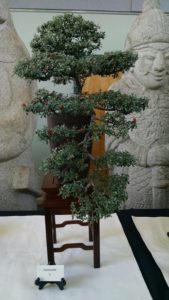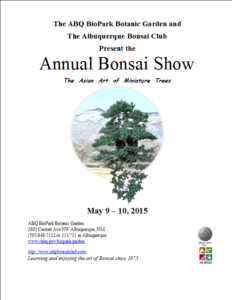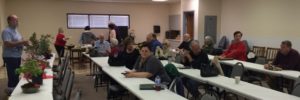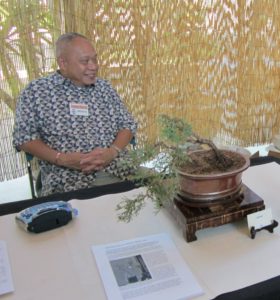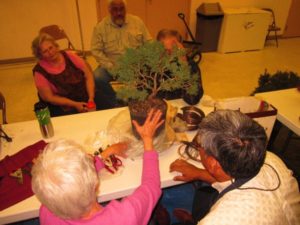Many of you will recall that in January of 2013, there was a crisis for the Bonsai community as the U.S. Department of Agriculture had placed a ban on the import of Akadama soil into the United States. Akadama is a basic ingredient in many soil compositions used throughout the Bonsai community. As it turned out, the ban was only temporary, but Triple Red Line Brand was permanently restricted. However, this resolution took several months (the government does move slowly at times). After some extensive searching and through the contacts of Roger Case, as a club we were able to place an order with a California operation which still had a supply of Akadama which had been received before the ban took effect.
Unsure of what the future for Akadama might be, and after talking with many of the local west coast Bonsai professionals, I determined to see if there were any materials available which had similar properties to Akadama but were native to the U.S. and would meet the requirements for a “good” Bonsai soil. Most sources of commercially prepared soils, bonsai enthusiast and bonsai professionals agree that a “good” bonsai soil will have the following characteristics:
- The soil composition must drain excess water quickly while retaining sufficient amounts to support the tree after watering.
- The soil composition must be non-compacting and provide space for oxygen exchange.
- Whether a single component or multiple components are used in the soil composition, they must be of a uniform size.
- The composition should have a neutral or near neutral “ph” factor (somewhere between 6.5 and 7.5 “ph”).
- The soil components should have a good “Cation Exchange Capacity” [CEC].
All of the other basic components (red and black lava rock, pumice, charcoal, and granite grit) for what is commonly referred to as “Boon Mix” continued to be readily available. The component needing a comparable replacement was the Akadama.
CATION EXCHANGE CAPACITY (CEC) is measurement of a soils capacity to retain nutrients. Clay (Akadama in this case) and organic matter have negative electrical charge These negatively charged soil particles will attract and hold positively charged particles (in the fertilizer you apply) much like opposite poles of magnets will attract
Elements having an electrical charge are called ions. Positively charged ions are called CATIONS and negatively charge ions are called ANIONS. [Cation is pronounced cat-eye-on; Anion (negative charges) is pronounced ann-eye-on].
Clay ions are always negatively charged and are therefore identified as ANIONS. Organic particles of soil may have either a positive or a negative electrical charge and can therefore be either a CATION or an ANION. CATIONS held on either clay or organic particles of soil can be replaced by other CATIONS, thus they are EXCHANGABLE.
The total number of CATIONS a soil can hold – or its total negative charge- is the soil’s CATION EXCHANGE CAPACITY. The higher the CEC, the higher the negative charge of the soil and the more CATIONS it can hold. The higher the CEC levels, the more fertile the soil.
The fact that CATIONS can be exchanged in the soil is the key factor in Bonsai plant health. The exchange factor allows for the positively charged nutrients to be ADSORBED onto the negatively charge clay or organic soil particles and then later released for ABSORPTION by the feeder roots of the plant as needed. ADSORB means that the positively charged nutrients attach to or cling to (think of static cling from the dryer) the negatively charged soil particles. The nutrients do not penetrate the surface of the soil particles, they simply cling to the surface until released or exchanged for other ions. Without the effect of CATION EXCHANGE CAPACITY, nutrients applied to the soil would simply wash out with the drainage of the applied water.
The CATION EXCHANGE CAPACITY scale ranges from a 1 (lowest level) to 100 (highest level) based on the type of soil and the “ph”. Sand has a CEC of 5 – 20; Clay has a CEC of 20 – 50; and organic soil has a CEC of 50 – 100. Depending on the particular lab reports, Akadama soil was identified as having a CEC of between 21 and 26.
So, if we need to find a replacement at sometime for Akadama in out mix, in order to meet the characteristics of a “good” Bonsai soil, we need an inert ingredient which has a neutral, or near neutral, “ph” and a CEC of between 20 and 30. In my research, I found 3 such soil components which I decided to use as part of the soil study and one “organic” based soil.
“Boon Mix” was used as a control and has a CEC value of 23. Wee Tree bonsai soil mix, which was screened for fines and then supplemented by additional lava rock, pumice, charcoal and granite grit, was included as it is close to an organic mix for CEC purposes, and after screening and supplementing it has a CEC value of 28. Diatomaceous Earth (DE) has a CEC value of 27, Haydite which has a CEC of 25, and Turface (MVP) with a CEC value of 30 were the other 3 soil components selected as having a neutral or near neutral “ph” and a CEC values within the 20 to 30 range. These soil components were mixed with lava rock, pumice, charcoal and granite grit in the “Boon Mix” proportions except for the Turface.
Turface came with a manufacture’s caution that in horticultural applications, the volume of the Turface in the soil composition should not exceed 10% to 15% due to a risk of the soil becoming nutrient toxic. It was therefore mixed at a ratio of 10%.
Once the soils were selected and prepared, they were all tested (measured) for Soil Permeability and Soil Porosity.
PERMEABILITY (sometimes referred to as Hydraulic Conductivity) is a measure of the ease with which fluids (mainly water) will flow through or be transmitted by a porous rock, sediment or soil. The packing (compression), shape, and sorting of granular material controls their permeability. Permeability is controlled by the size of the particles of the sample soil, the consistency of the size of the particles, the size of the pores or void between the particles and the degree to which the pores or voids are interconnected. Generally, materials of larger particle size which are consistently sorted will be more permeable.
POROSITY is a measure of the open spaces (voids) or pores found within a particular soil or sediment. The open space in a soil sample is comprised of the open spaces between the particles themselves and within the cracks, crevices, or cavities between or on the soil particles themselves. Porosity determines the total amount of water a soil or sediment will hold. Porosity is largely influenced by factors of particle size, shape and assortment. The greater the column of pore spaces a material contains, the higher its porosity and the more water it can hold. Porosity is expressed as a fraction or a percentage of the volume of the pore space to the total volume of the material.
Here is quick analysis of measuring for Total Porosity, Soil Porosity and Percentage of Air in a soil mix. REMEMBER: THE EXAMPLE PRESENTED BELOW IS BASED ON USING A BALANCED MIX FOR THE SOIL. EACH OF THE PRIMARY COMPONENTS OF THE SOIL MIX CAN HAVE A DIFFERENT POROSITY VALUE FROM THAT OF THE MIX ITSELF. YOU CAN THEREFORE CONTROL (RAISE OR LOWER) SOIL POSOSITY BY CHANGING THE PERCENTAGE OF EACH COMPONENT USE IN THE MIX.
TOTAL POROSITY — The amount of water accepted by the measured amount of soil mix. (In this example the amount of soil is 8.5 ounces.)
SOIL POROSITY — Amount of water retained in soil mix sample after draining. This is the amount of water in the soil which will be available to the plant. Not all of the retained water is available to be used by the plant due to being absorbed within the particles of the soil and due to the effects of the surface tension of water.
PERCENTAGE OF AIR IN SOIL — Air filled space within the soil sample after drainage from initial TOTAL POROSITY stage.
HOW TO MEASURE — For our example the initial volume of soil is 8.5 ounces.
TOTAL POROSITY is the amount of water that is accepted by the soil sample to reach total saturation.
Record this number. (For example if the soil sample accepts 6 ounces of water to reach total saturation, record 6 ounces. Allow the soil sample to stand covered in the water for 30 minutes.)
SOIL POROSITY — The amount of water remaining in the soil sample after drainage from the original TOTAL PROSITY amount of water. (For example, the amount of water that drains from the soil sample equals 2.5 ounces. Subtracting 2.5 oz. from 6 oz. means that 3.5 oz. remains within the soil sample. Record3.5 oz.)
PERCENTAGE OF AIR IN SOIL SAMPLE — The percentage of air remaining in the soil sample is equal to the amount of drainage water collected. (In our example this was 2.5 oz. Record this number)
To determine the TOTAL POROSITY, SOIL POROSITY, AND PERCENTAGE OF AIR in the soil sample divide each recorded number by 8.5 and then multiply the result by 100.
TOTAL POROSITY = 6.0 divided by 8.5 = .70 — .70 x 100 = 70.5. The TOTAL POROSITY in the example is 70.5 percent.
SOIL POROSITY = 3.5 divided by 8.5 =0.41. — .41 x 100 = 41. SOIL POROSITY in the example is 41 percent.
PERCENTAGE OF AIR IN THE SOIL SAMPLE = 2.5 divided by 8.5 = .29. — .29 x 100 = 29. PERCENTAGE OF AIR in the example is 29 percent.
I then determined that in order to conduct as fair an analysis of the 5 soil mixes as possible, I would select 5 of the most popular trees grown for Bonsai, obtain 5 of each species of tree (all were one year old cuttings or seedlings) and plant one of each tree in the five soil mixes. The trees that were selected were Japanese Black Pine, Korean Hornbeam, Japanese Larch, Trident Maple and Shimpaku Juniper. All of the trees were planted in the first week of March, 2013.
2013 Progress, Outcomes and Observations — All 25 trees were planted in 4 inch nursery pots the first week in March, 2013. There was one of each species of tree planted in each of the 5 soil compositions. After planting, the trees were placed in a protected area of my un-heated green house were they would get plenty of light. In mid May, they were given their first fertilization which was comprised of 20-20-20 mixed at 1/4 strength combined with fish emulsion and kelp meal at 1/2 strength. This feeding formula was repeated every 14 days for the remainder of the growing season.
All of the trees appeared to prosper until about mid July when it became apparent that the 5 trees growing in the Turface MVP mix were not as healthy as the other trees. By early September two of the trees growing in the Turface mix had died and the other 3 were definitely weaker than the other 20 trees. A careful unpotting of the 2 trees which had died revealed that the problem was the Turface mix remained too wet and the roots had rotted. Remember, the Turface composition was only 10% Turface. I immediately reduced the amount of water the other 3 trees in the Turface soil mix were getting.
All of the other 20 trees in the other 4 soil mixed grew tremendously. By late October, the maples, hornbeam and larch had all grown more than 2 feet in height. After their leaves and needles had turned, they were all lightly branch trimmed and reduced in height to approximately 15 inches. The black pine and juniper had extended approximately 2 to 3 inches. The real surprised to me was that the roots (on these 20 trees) had completely filled the 4 inch pots and grown out through the drainage holes and several inches into the gravel floor of my greenhouse. All would need to be repotted in late winter of 2014.
One observation that I made when lifting the trees out of the gravel floor was that there was tremendous growth of feeder roots on the roots that had extended into the gravel. The roots extending outside the pots were trimmed off. I therefore had expectations that the pots would be full of strong feeder roots when I repotted.
2014 Progress, Outcomes and Observations — In late February, all of the trees were showing signs of bud swell and so repotting was in order. Remembering the tremendous feeder root growth in the gravel floor of my greenhouse, I was slightly disappointed when I commenced repotting. While the 4 inch pots were quite full of strong roots, they were long and fibrous, but not nearly as dense with feeder roots as I anticipated.
The soil around the root ball and under the root ball was lightly loosened with a few strokes from a chopstick on all of the trees. All of the trees were repotted into 6 inch bulb pots and additional amounts of the appropriate soil compositions were added.
The 3 remaining trees in the Turface composition were still weak, and their roots did not fill the 4 inch pots as with the other 20 trees. As the roots were only in the top 1/3 of the pot, I determined to apply a small amount of rooting hormone to the root balls and to increase the particle size of the soil mix to 1/4 inch and to increase the pot size to 6 inches as with all of the other trees. I also determined to reduce the watering routine for these 3 trees so as to hopefully promote a drier soil.
Once all of the trees had been repotted, they were again returned to the greenhouse for the new season. The fertilization routine for 2014 was the same as it was in 2013. Again, all of the trees displayed tremendous growth. The 3 trees in the Turface mix responded favorably to the change in the soil size of the mix, although they did not show the progress of the other trees in the other mixes. Again, for the other 20 trees, the roots filled the six inch pots and grew into the gravel floor of the greenhouse.
In late October, as the trees were being prepared for the winter, I saved some of the feeder root masses growing in the gravel of the greenhouse floor. Over the winter I wanted to study these. I also took a slight risk and lifted the strongest tree in each soil mix and collected a root to also study over the winter. Clearly, all of the trees will need to be repotted in the late winter of 2015 and will move up into 8 inch bulb pots.
Late 2014 and Early 2015 observations. At this point, I feel comfortable in saying that I would most definitely never use Turface in any soil mix for Bonsai again. Turface simply retains too much water. Even after changing the size of the soil mix in 2014, the 3 trees do not show the health and vigor of any of the other 4 compositions. It also appears to decompose or degrade into sludge rather fast. The original soil mix which was left on in the transplant of 2014 now has very little granular structure left. I will know more when I look at the trees during repotting in a few months.
Of the 4 other compositions of mix that I have evaluated in this study, they all appear to support the development and growth of the trees and the root systems. Clearly, the CEC value of the various soil compositions was favorable to the trees, and with the exception of Turface would appear to satisfy the quest for a “good” Bonsai soil.
When I took the root samples I had collected when I lifted the trees to a Master Gardener office and did some examination under a microscope, there were some obvious differences in the root development. The first thing I noticed was that while there were soil particles clinging to the roots in all of the samples, only in the Akadama mix did the root actually penetrate through the soil particle and emerge out the other side. The root actually impaled the soil particle. A close look at a dry Akadama particle revealed that there are tubular structures within the Akadama particle which in many cases actually traverse the entire particle. Therefore, these particles will cling to the root until they decompose or until the root expands to the extent that the root fractures the particle. All of the other mixes revealed that the roots were growing only in or through surface irregularities and crevices of the composition particles.
Additionally, a microscopic examination of the feeder root clusters growing into the gravel of the greenhouse floor showed that these roots had multiple divisions of the roots where they had pushed against sharp edges of the gravel. But why were these roots so much healthier than the roots in the pots? A friend at the OSU agriculture labs asked me to bring the root samples in to him along with samples of the various soil mixes and a bucket of the greenhouse gravel. After putting the roots under the microscope, he and I sieved the 2 gallons of greenhouse grave.
Although the gravel in my greenhouse was rated as 1/4 inch minus in size, what we found was that the particle size of the mix was actually (according to the sample) approximately 20% in the 1/4 to 1/2 inch minus size. It was this additional size of particle in the mix which accounted for the healthier root development. There was more oxygen in the gravel mix in the greenhouse than there was in the uniform size of particles in the pots. This mix of larger sized particles provided more space for oxygen to collect as the water drained down. Roots need water, oxygen and nutrients to develop. The additional oxygen spaces were key.
I intend to test this concept with the next repotting. I have sufficient screened components of each of the soil mixes available that I will be able to add 20% of soil volume in the 1/4 to 1/2 inch size and incorporate that throughout the soil mix in the larger 8 inch pots. If the concept proves positive, I expect that during repotting in 2016 I will find significantly more of the feeder roots throughout the root mass inside the pots.
So the take away from 2 years of this study is:
- Akadama is still probably the best soil mix component of all of the ones tested.
- Akadama will allow the tree roots to literally penetrate right through it.
- It is possible to control (raise or lower) soil porosity by changing the percentage of each component in the mix, therefore you must test the porosity of each component as well as the porosity of the final mix.
- Soils with similar CEC values will provide excellent root development and trees growth very similar to Akadama although Akadama has some clear advantages.
- Better root development appears to be possible with soil mixes containing a combination of similar sized particles as opposed to a single uniform size.
So there you are. Two years worth of observations and study. Have a great new year and remember, spring is coming so get your repotting materials, tools and your plan ready.
—Keith Wingfield


